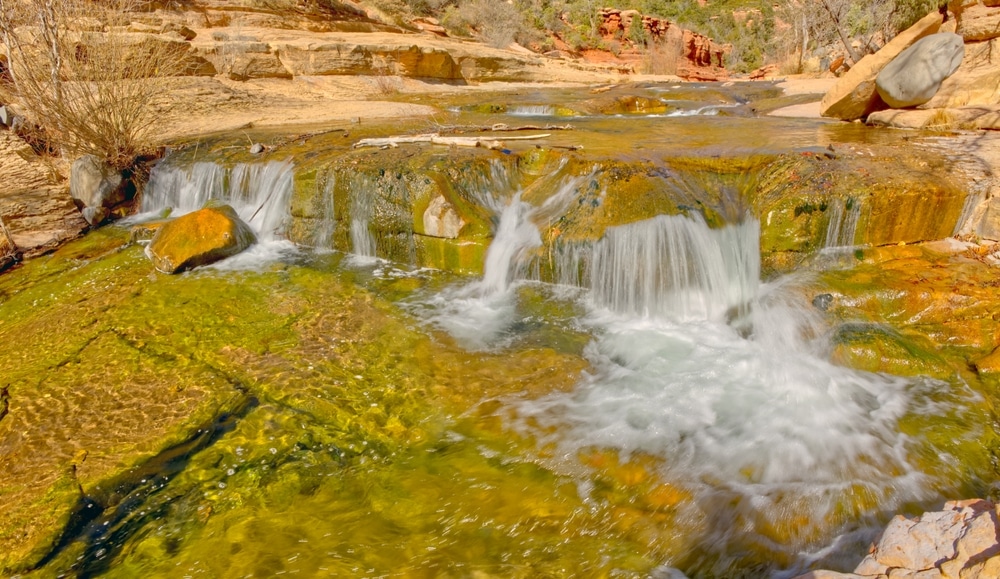- Privacy
- Terms
- Stay Connected
Nestled within the stunning red rock landscape of Oak Creek Canyon, just 7 miles north of Sedona, Slide Rock State Park stands as one of Arizona’s most beloved natural attractions. This 43-acre historic site combines the rich agricultural heritage of the Pendley Homestead with the refreshing allure of Oak Creek’s famous natural water slide, creating an unforgettable destination for visitors of all ages.
The park takes its name from an 80-foot stretch of slippery creek bed that has been smoothed by the constantly flowing waters of Oak Creek, creating a natural water slide that draws thousands of visitors each year. Often ranked among America’s top swimming holes, this natural feature has made Slide Rock one of Arizona’s most visited tourist attractions.

The land was first developed by Frank L. Pendley, who arrived in the canyon in 1907 and acquired title to the land under the Homestead Act in 1910. Through remarkable innovation, Pendley succeeded where others had failed by establishing a unique irrigation system that is still in use today. This allowed him to plant his first apple orchard in 1912, beginning a pattern of agricultural development that would define the site for generations.
The park’s historical significance extends beyond agriculture. The completion of the canyon road in 1914 and its paving in 1938 were pivotal in encouraging recreational use of the canyon. Recognizing the tourism potential, Pendley built rustic cabins in 1933 to accommodate vacationers and sightseers, further cementing the area’s reputation as a premier destination. Today, the park preserves one of the few intact homesteads remaining in Oak Creek Canyon, offering visitors a glimpse into early agricultural development in Central Arizona while providing access to one of the state’s most cherished natural playgrounds.

The striking combination of red rock formations, clear flowing water, and historic structures creates exceptional photography opportunities. The contrast between red sandstone and green vegetation is particularly vibrant after rainfall, while the historic farm buildings offer compelling architectural subjects. Morning and evening light brings dramatic shadows and warm tones to the canyon walls, while water features provide endless creative possibilities with varied shutter speeds.

The park preserves the historic Pendley Homestead, an apple farm established in 1907 that operated for decades. Visitors can tour the original farmhouse, apple packing barn, and various outbuildings that have been restored to reflect their early 20th-century appearance. Interpretive displays explain the challenges and innovations of early agriculture in Oak Creek Canyon, including the irrigation systems that made farming possible in this desert environment.

Slide Rock State Park’s centerpiece attraction is its namesake natural water slide, where Oak Creek flows over smooth red sandstone creating a 80-foot slippery chute. Visitors can slide down the polished rock surface through refreshing pools and gentle rapids. This unique geological feature provides an exhilarating yet family-friendly experience unlike any other swimming spot in Arizona. The slide area includes several pools of varying depths, accommodating different swimming abilities and offering places to relax between slides.

Several short trails wind through the park, showcasing both the natural environment and historic features. The Pendley Homestead Trail offers easy access to historic buildings and farming equipment, while the Clifftop Nature Trail provides panoramic views of the entire canyon. These paths feature interpretive signage explaining the geology, ecology, and human history that make Slide Rock unique among Arizona state parks.

The historic apple orchards remain productive, with blossoming trees creating spectacular displays in spring (typically April) and fruit-bearing trees showing their bounty in late summer and fall. While fruit picking is not permitted, visitors can observe heritage apple varieties rarely seen in commercial production today. Interpretive information explains the importance of apples to the homestead’s economy and the techniques used to maintain orchards in this challenging environment.

The riparian corridor along Oak Creek supports diverse bird species not commonly found in drier Arizona environments. Canyon wrens, belted kingfishers, and various warblers are frequently spotted, while lucky observers might glimpse colorful western tanagers or black-headed grosbeaks. The combination of water, cliff faces, and varied vegetation creates multiple habitats supporting different bird communities throughout the seasons.

Multiple designated picnic areas throughout the park offer tables, grills, and shade ramadas with spectacular views of Oak Creek Canyon. These facilities are strategically placed among native trees providing natural shade during midday hours. The creek-side picnic spots create perfect settings for family gatherings with the soothing sounds of flowing water as background ambiance.

| Detail | Information |
|---|---|
| Location | Sedona, Arizona (Oak Creek Canyon) |
| Established | 1987 |
| Size | 43 acres |
| Main Feature | Natural water slide formed by slippery bed of Oak Creek |
| Slide Length | 80 feet |
| Historical Use | Former apple orchard (Pendley Homestead) |
| Elevation | Approximately 4,900 feet |
| Water Temperature | Typically 50-70°F (varies by season) |
| Historical Buildings | Pendley Homestead house, apple packing shed, various ranch structures |
| Orchard History | Frank Pendley established apple orchards in 1912, some trees still producing |
| Activities | Swimming, sliding, hiking, fishing, picnicking, photography |
| Trails | Short hiking trails along the creek and viewpoints |
| Red Rock Views | Surrounded by Sedona’s famous red sandstone formations |
| Peak Season | Summer months (especially June-August) |
| Facilities | Restrooms, picnic tables, parking, observation decks |
| Recognition | Listed on the National Register of Historic Places |
| Notable Geology | Coconino sandstone creates the slippery chute of the slide |
| Wildlife | Riparian species, various birds, occasional sightings of larger mammals |
The centerpiece of Slide Rock State Park is undoubtedly its namesake natural water slide, formed by the smooth, slippery bed of Oak Creek. This 80-foot-long, 2.5 to 4-foot-wide natural chute features a 7 percent decline from top to bottom, creating the perfect conditions for visitors to slide down into the cool, refreshing pools below. The slipperiness comes from a layer of algae that grows on the sandstone creek bed, which helps create the ideal sliding surface while adding to the unique ecosystem of the area.
Oak Creek itself is the lifeblood of the park, flowing through the canyon and creating a diverse riparian habitat. The creek is approximately a half-mile long within the park boundaries and varies in depth, offering various swimming and wading opportunities beyond just the famous slide. The water remains cool even during Arizona’s hot summer months, making it a popular destination for those looking to escape the heat.
The park sits within the stunning landscape of Oak Creek Canyon, surrounded by towering red rock formations characteristic of the Sedona region. These impressive geological features create a dramatic backdrop for visitors enjoying the creek. The red sandstone walls rise dramatically on either side of the canyon, showcasing the distinctive colors that have made this region famous worldwide.
The elevation of Slide Rock State Park is approximately 4,900 feet above sea level, placing it in a transition zone between desert and mountain ecosystems. This unique positioning contributes to the park’s diverse plant and animal life and creates a pleasant microclimate that’s often cooler than nearby desert areas.
The watershed of Oak Creek is part of the larger Verde River basin, with the creek eventually flowing into the Verde River. The water quality is regularly monitored, especially during peak swimming seasons, to ensure visitor safety. The clear waters of Oak Creek make it not only perfect for swimming but also ideal for fishing, with several species of trout making their home in the creek’s cooler sections.
Slide Rock State Park hosts a rich diversity of plant and animal life, thanks to its unique position in a riparian corridor within Oak Creek Canyon. This ecological transition zone supports species from both desert and mountain habitats, creating a biological hotspot within Arizona’s varied landscape.
The riparian areas along Oak Creek feature magnificent stands of native trees, including Arizona sycamore (Platanus wrightii), Fremont cottonwood (Populus fremontii), velvet ash (Fraxinus velutina), and box elder (Acer negundo). These water-loving trees provide essential shade along the creek and crucial habitat for wildlife. Willows (Salix gooddingii) and canyon grape (Vitis arizonica) also thrive in these moist environments.
Away from the creek, the upland vegetation consists of species more adapted to drier conditions, including ponderosa pine (Pinus ponderosa), Emory oak (Quercus emoryi), Gambel oak (Quercus gambelii), Utah juniper (Juniperus osteosperma), and oneseed juniper (Juniperus monosperma).
The park is home to an impressive variety of wildlife. The most recognizable mammal species include the Coues white-tailed deer, a diminutive subspecies native only to Arizona, New Mexico, and northern Mexico. These graceful deer can often be spotted throughout the park, offering visitors excellent wildlife viewing opportunities. Collared peccaries, commonly known as javelina, also frequent the park, typically moving in small family groups through the underbrush. Other mammals commonly seen include gray foxes, raccoons, and Arizona bushy-tailed woodrats.
Bird enthusiasts will be delighted by the park’s avian diversity, with over 140 species documented within its boundaries. Year-round residents include the vibrantly colored Steller’s jays, whose bright blue plumage contrasts beautifully with the red rock backdrop. Hummingbirds buzz around flowering plants, while pinyon jays, gray flycatchers, Scott’s orioles, and gray vireos add to the birdwatching experience. The riparian corridor serves as an important migration route, bringing seasonal visitors throughout the year.
Oak Creek itself supports a healthy aquatic ecosystem, with rainbow trout and brown trout being the most sought-after species by anglers. The rainbow trout are regularly stocked, while the brown trout have established wild, self-sustaining populations. These fish thrive in the clear, cool waters of Oak Creek, particularly in the stretches upstream from the park’s main swimming areas.
Like many areas in Arizona, Slide Rock State Park faces challenges from non-native plant species. Visitors might encounter introduced plants such as dandelion, puncture vine, periwinkle, wand mullein, blackberry, and Dalmatian toadflax within or near the park boundaries. Park management works to control these invasive species to maintain the native ecosystem’s integrity.
Seasonal changes bring dramatic transformations to the park’s landscape. Spring brings wildflowers and increased activity among wildlife, while fall transforms the deciduous trees into brilliant displays of yellow, orange, and red, making autumn a particularly photogenic time to visit the park.
Slide Rock State Park offers an exciting array of recreational opportunities centered around its natural water features and scenic landscape, making it a versatile destination for outdoor enthusiasts of all kinds.
Water activities are the main attraction at Slide Rock, with the natural water slide being the star experience. Visitors of all ages delight in slipping down the 80-foot sandstone chute, propelled by the flowing waters of Oak Creek. Beyond the slide itself, the park offers approximately a half-mile of creek access for swimming and wading. The clear, cool waters create natural pools perfect for relaxing on hot summer days.
Water temperatures remain refreshingly cool even during the hottest months, though visitors should note that in winter and early spring, the creek can be extremely cold. For safety, water shoes are highly recommended as the algae that makes the slide slippery can make walking on the rocks treacherous.
Fishing is another popular activity, though it takes place primarily upstream from the main swimming area, between the park boundary and the West Fork confluence. This stretch of Oak Creek is home to both wild brown trout and stocked rainbow trout, offering excellent opportunities for anglers. All fishing in Oak Creek requires an Arizona fishing license for anyone over the age of 10. The best fishing is typically early in the morning or late in the evening when the waters are less crowded with swimmers.
The park features three short hiking trails that allow visitors to explore beyond the creek area:
While the trails within the park are relatively short, more ambitious hikers can access additional trails in the surrounding Coconino National Forest. The park serves as an excellent starting point for exploring the broader Oak Creek Canyon area.
Photography opportunities abound throughout the park. The contrast of red rocks, green vegetation, and the clear waters of Oak Creek creates stunning compositions. Wildlife photography is rewarding as well, with opportunities to capture images of deer, javelina, and numerous bird species. The historic structures and antique farm equipment provide interesting subjects for those interested in historical photography.
Stargazing is another activity worth considering, especially during clear nights when the relative isolation from major urban areas allows for excellent views of the night sky. The canyon setting creates a natural frame for celestial observation, though visitors should check park hours, as they vary seasonally and the park is not open for overnight use.
While Slide Rock State Park itself does not offer overnight camping facilities, several excellent campgrounds are located nearby in Oak Creek Canyon, providing convenient access for visitors planning multi-day explorations of the area.
The closest camping options are managed by the U.S. Forest Service within the Coconino National Forest:
Cave Springs Campground, located about 5 miles north of Slide Rock State Park, is one of the most popular options. This well-developed campground offers 84 campsites nestled among sycamore trees along the banks of Oak Creek. Facilities include vault toilets, drinking water, and showers. The campground operates seasonally, typically from mid-April through late October, and reservations are strongly recommended due to high demand. While it doesn’t offer electrical hookups or a dump station for RVs, the campground can accommodate both tent campers and smaller recreational vehicles. Its location along Oak Creek offers excellent fishing opportunities and a cooler environment during hot summer months.
Manzanita Campground, a smaller facility with 19 sites designed primarily for tent camping. Located along Oak Creek, this intimate campground offers a more primitive camping experience while still providing basic amenities such as vault toilets and drinking water. Like Cave Springs, reservations are essential during peak season.
Pine Flat Campground, also located along Highway 89A in Oak Creek Canyon, offers additional camping opportunities with similar amenities to the other Forest Service campgrounds. Its proximity to the creek makes it popular for swimming and fishing.
For those seeking more comfortable accommodations, numerous lodging options are available in nearby Sedona, ranging from luxury resorts to budget-friendly hotels and vacation rentals. The town of Sedona, just 7 miles south of the park, offers a full range of services, including restaurants, shopping, and guided tours of the area.
Visitors planning to camp near Slide Rock should be aware that sites fill extremely quickly, especially during summer months and weekends. Reservations can be made up to six months in advance through the recreation.gov website or by calling the Forest Service reservation system. Last-minute camping can be very difficult to secure in this popular area.
For day visitors to Slide Rock who want to bring along picnic supplies and comfort items, the park offers two covered ramadas with electrical outlets and picnic bench seating. Each ramada accommodates approximately 50 people and can be reserved for $95, except during the peak season between Memorial Day and Labor Day when reservations are not accepted. The park also features numerous individual picnic tables scattered throughout the grounds, available on a first-come, first-served basis.
Planning a successful visit to Slide Rock State Park requires some advance preparation, especially during the busy summer season when this popular destination can reach capacity early in the day.
The park operates year-round with seasonal hours:
Entrance fees vary seasonally:
One crucial planning consideration is the park’s popularity and limited parking. During summer months, especially weekends and holidays, the parking lot often fills to capacity before mid-morning, sometimes as early as 9 a.m. Once the lot is full, the park closes to additional visitors until space becomes available, regardless of the official operating hours. Vehicle entry is the only way to access the park; walk-ins and drop-offs are not permitted.
The best times to visit for smaller crowds are weekdays, particularly during the shoulder seasons of late spring (April-May) and early fall (September-October). These periods typically offer comfortable temperatures and lower visitor numbers. Fall brings the added bonus of seasonal color as deciduous trees display their autumn foliage.
Weather considerations vary throughout the year:
The water temperature in Oak Creek remains cool year-round, providing refreshing relief in summer but potentially being uncomfortably cold during other seasons.
Accessibility at Slide Rock is limited by the natural terrain. The main path to the creek is paved but steep in sections. Once at the creek level, the natural rock surfaces are uneven and often slippery, making navigation difficult for those with mobility challenges. The park does offer accessible restrooms and some viewing areas that provide glimpses of the scenery without requiring the full descent to the creek.
Pets are welcome in most areas of the park but must be kept on a leash no longer than six feet at all times. However, pets are not allowed in the water or swimming areas, so visitors planning to enjoy the creek should make appropriate arrangements for their animals.
Cell phone service can be limited within Oak Creek Canyon due to the surrounding rock walls. While some carriers may provide coverage in parts of the park, visitors should not rely on consistent service for navigation or communication. Wi-Fi is not available within the park.
Slide Rock State Park offers a variety of facilities and amenities designed to enhance visitor comfort and enjoyment while preserving the natural and historical character of this unique site.
The park entrance and main parking area serve as the hub for visitor services. Here, visitors will find the entrance station where fees are collected and basic information is provided. The parking lot accommodates approximately 100 vehicles, though this is often insufficient during peak visiting times, contributing to the park’s capacity limitations.
The Slide Rock Market, located just off the main paved path through the park, operates year-round with seasonal hours. This store offers a variety of convenience items including ice, snacks, water, sunscreen, and other limited necessities, as well as Slide Rock State Park memorabilia and souvenirs.
Market Hours:
Restroom facilities with flush toilets and running water are available near the parking area, providing clean and well-maintained services for visitors. Additional portable restrooms may be added during extremely busy periods. Drinking water is available at several locations throughout the park, and visitors are encouraged to bring refillable water bottles to stay hydrated, especially during hot summer days.
Picnic facilities are plentiful throughout the park. In addition to the two reservable ramadas mentioned previously, there are approximately 15 individual picnic tables located in a meadow near the parking lot, available on a first-come, first-served basis. These areas provide a pleasant setting for meals and relaxation away from the busy creek area. Charcoal fires are permitted only in designated grills, while wood fires are prohibited. Propane grills and stoves are allowed for cooking.
The historic Pendley Homestead area includes several preserved structures that serve both as historical exhibits and visitor amenities. A gazebo-style kiosk with eight poster boards displays information about the Pendley Homestead and general park information, providing context for the site’s agricultural and tourism history.
The historic apple packing shed houses exhibits on the orchard’s operations, including the Bean Cutler 1933 Sorter and Bean Cutler Polisher added in 1946. On scheduled days, a ranger is available at the packing shed to answer questions about the homestead’s history.
Along the main paved path and the Pendley Homestead Trail, visitors will find displays of historic farm implements that offer insight into early 20th-century agricultural practices while providing interesting photo opportunities. These displays help tell the story of Frank Pendley’s innovative farming techniques that allowed him to succeed where others had failed.
While there is no developed beach area along Oak Creek, numerous natural rock formations create ideal spots for sunbathing and creek access. The main slide area is the most popular, but visitors can find less crowded spots both upstream and downstream within the park boundaries.
It’s important to note that there are no lifeguards on duty in the swimming areas. Visitors use the slide and swimming areas at their own risk, and parents are advised to closely supervise children at all times. The combination of flowing water and slippery surfaces requires caution, and water shoes are strongly recommended for better traction.
Slide Rock State Park sits at the heart of one of Arizona’s most scenic and activity-rich regions, making it an ideal base for exploring numerous nearby attractions. Whether you’re interested in natural wonders, cultural sites, or charming communities, the surrounding area offers something for everyone.
Just 7 miles south of the park lies the internationally renowned town of Sedona, famous for its stunning red rock formations and vibrant arts community. Sedona offers extensive shopping, dining, and lodging options, as well as numerous art galleries showcasing local and Southwestern artists. The town serves as a hub for guided tours, including popular jeep excursions that explore the surrounding backcountry. Many visitors combine a morning at Slide Rock with an afternoon exploring Sedona’s attractions.
West Fork Trail: Located just a few miles north of Slide Rock within Oak Creek Canyon, this popular hiking trail follows West Fork Creek through a scenic canyon with multiple creek crossings and magnificent views. The relatively flat trail is suitable for most fitness levels and offers a different perspective on the canyon ecosystem compared to Slide Rock.
Red Rock State Park: Located about 16 miles south of Slide Rock, provides another perspective on the region’s famous red rock formations. This 286-acre nature preserve offers educational programs and miles of interconnected hiking trails through diverse habitats, with spectacular views of Cathedral Rock and other formations.
Just outside the park, Indian Gardens Market & Café provides food, supplies, and a relaxing spot to enjoy a meal under towering trees. This long-established waypoint in Oak Creek Canyon also features booths with Native American arts and crafts, making it a convenient stop for refreshments and souvenirs.
Flagstaff: Located approximately 20 miles north from Slide Rock, this mountain town offers a complete contrast to the red rock landscape of Sedona. With its ponderosa pine forests and proximity to the San Francisco Peaks, Flagstaff is home to Northern Arizona University, the historic downtown area, the Lowell Observatory, and serves as a gateway to the Grand Canyon, which is about 80 miles further north.
Verde Valley Region: For those willing to venture a bit further, the Verde Valley region offers several fascinating destinations. Approximately 27 miles southwest of Slide Rock is Dead Horse Ranch State Park near Cottonwood, offering camping, fishing, and bird watching along the Verde River.
Historic Mining Towns: The nearby towns of Jerome, a historic mining community perched on the side of Cleopatra Hill, and Cottonwood, with its charming Old Town district, provide interesting day trips with shopping, dining, and wine tasting opportunities.
The entire region surrounding Slide Rock State Park is part of the Coconino National Forest, which encompasses about 1.8 million acres of diverse landscapes ranging from red rock formations to ponderosa pine forests. The forest offers extensive recreational opportunities, including hiking, mountain biking, and scenic drives.
During the fall months, the drive through Oak Creek Canyon itself becomes an attraction, as the deciduous trees along the creek put on a brilliant display of autumn color. This seasonal phenomenon draws photographers and nature enthusiasts from across the state, making it one of Arizona’s most popular leaf-peeping destinations.
Slide Rock State Park represents a successful balance between recreational access and environmental preservation, demonstrating how proper management can protect natural and historical resources while accommodating thousands of visitors annually.
The park’s conservation story began with its establishment in 1985, when Arizona State Parks purchased the land from the Arizona Parklands Foundation. In 1987, it was officially dedicated as Slide Rock State Park, preserving both its natural features and historical significance. The Pendley Homestead Historic District gained additional recognition when it was accepted onto the National Register of Historic Places on December 23, 1991, acknowledging the site’s importance in the agricultural development of the region.
Today, the park operates under a unique co-management arrangement between Arizona State Parks and Trails and the U.S. Forest Service, as the park is located on Coconino National Forest land. This partnership allows for coordinated conservation efforts across jurisdictional boundaries, addressing both the recreational needs of visitors and the environmental health of the broader Oak Creek ecosystem.
Water quality monitoring is one of the most critical conservation activities at Slide Rock, with regular testing conducted to ensure visitor safety, particularly during peak swimming season. Oak Creek’s water quality can be affected by various factors, including upstream activities and seasonal runoff patterns. Park management works diligently to maintain water quality standards and posts advisories when conditions warrant.
Slide Rock State Park is an active member of the Oak Creek Canyon Task Force (OCCTF), a non-profit watershed group dedicated to protecting and preserving the integrity of Oak Creek and the canyon environment. This collaborative approach brings together various stakeholders from throughout the watershed to address common conservation challenges and develop sustainable solutions.
Visitor education plays a central role in the park’s conservation strategy. Interpretive displays and programs inform visitors about the area’s ecological importance and fragility, encouraging responsible behavior during their visit. Rangers and staff regularly interact with visitors to answer questions and promote sustainable practices.
The “Leave No Trace” principles are actively promoted throughout the park, with particular emphasis on proper waste disposal. Trash receptacles are strategically placed, and visitors are encouraged to pack out what they pack in, especially in areas away from developed facilities. Glass containers are strictly prohibited throughout the park due to the hazards broken glass would pose in the popular swimming areas and the difficulty of removing it from the creek bed.
The park faces several conservation challenges, including the management of non-native plant species that threaten to displace native vegetation. Park staff work to control invasive species through various management techniques while promoting the health of native plant communities. Additionally, the high volume of visitors during peak seasons creates challenges related to erosion control, vegetation protection, and maintaining water quality.
Volunteer opportunities are available for those wishing to contribute to the park’s conservation efforts. The Friends of Slide Rock State Park, a volunteer support organization, helps with various projects ranging from trail maintenance to historical preservation work. This group also helps raise funds for park improvements through events such as the specialty brew tasting, partnering with local businesses like Historic Brewing Company.
Educational programs offered at the park include guided walks, historical demonstrations at the apple packing shed, and seasonal apple harvesting activities in the orchard. These programs connect visitors to both the natural environment and the cultural history of the site, fostering a deeper appreciation for the park’s resources.
Through these various conservation and stewardship efforts, Slide Rock State Park strives to ensure that future generations will continue to enjoy this unique natural playground while preserving its ecological integrity and historical significance. The park serves as a model for how recreational access and resource conservation can work hand in hand when managed with care and foresight.